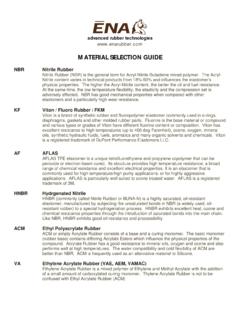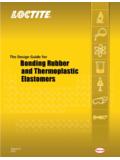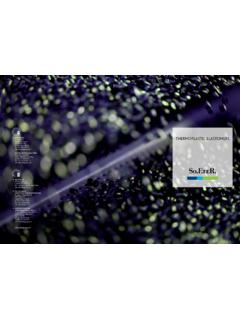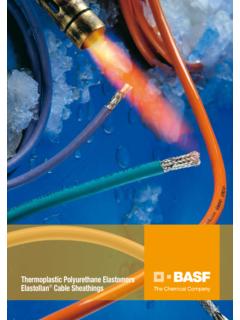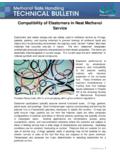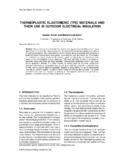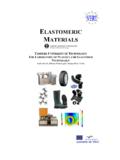Transcription of ENA Shelf Life of Elastomers - enarubber.com
1 _____ Storage life Note: The following document is for general reference only. Please contact ENA Advanced Rubber Technologies support staff for detailed information on storage life of your particular elastomer compounds, storage conditions, etc. According to SAE-ARP5316 issue 1998-11, Revisal 2002-11, storage life is the maximum period of time, starting from the time of manufacture, that an elastomeric seal element, appropriately packaged, may be stored under specific conditions, after which time it is regarded as unserviceable for the purpose for which it was originally manufactured. The time of manufacture is the cure date for thermoset Elastomers or the time of conversion into a finished product for the thermoplastic Elastomers . Shelf life of Elastomers when stored properly is especially determined by the specific compound.
2 Table 1 is taken from MIL-HDBK-695C and distinguishes 3 basic groups of Elastomers . The values in this chart are minimal values. In practice, longer storage periods may be used especially when 10 or 20 year categories are involved provided the parts are properly stored and periodic checks are performed. Generally, polyethylene bags stored in cardboard containers or polyethylene lined craft paper bags insure optimal storage life . Due to major improvements in compounding techniques, storage life of relatively age-sensitive Elastomers in normal warehousing conditions is considerable improved. MIL-HDBK-695C provides guidelines for recommended Shelf life for different O-ring compounds. See Table 1, MIL-HDBK-695C, page Technical Documentation Storage life of Rubber Materials Date: 12-15-2010 Table 1 MIL-HDBK-695C Type of Rubber Common Trade Name ASTM D1418 Abbreviation ASTM D2000 Abbreviation MIL-STO-417 Abbreviation 20 Years or Higher: Silicone Silicone Q FE TA Fluoro-silicone Silastic LS FVMQ FK TA Polysulfide Thlokol T SK SA Fluorocarbons Fluorei, Viton FKM HK - Polyacrylate Acrylic ACM, ANM DF, DH TB Up to 10 Years.
3 Chlorosulfonated Polyethylene Hypalon CSM CE - Isobutylene-Isoprene Butyl IIR AA, BA RS Polychloroprene Neoprene CR BC, BE SC Polyether Urethane Urethane EU BG - Polypropylene oxide Propylene Oxide GPO - - Ethylene-Propylene Ethylene Propylene EPDM BA, CA - Ethylene-Propylenedienne Ethylene Propylene Copolymer EPM BA, CA - Epichlorohydrin Hydrin 100 CO - - Up to 5 Years: Butadiene-Acrylonitrile Nitrile, NBR NBR BF, BG, SK SB Butadiene-Styrene SBR SBR AA, BA RS Cis-polybutadiene Butadiene BR AA RN Cis 1,4, polyisoprene Natural pale crepe NR AA RN Cis 1,4, polyisoprene Synthetic natural IR AA RN Storage and Age Control of Elastomers . Experience has demonstrated that storage conditions are much more important in determining the useful life of O-rings than is time.
4 SAE-ARP5316 addresses the general requirements for data recording procedures, packaging, and storing of aerospace elastomeric seals: 1. Temperature. The storage temperature shall be below 100 deg F (38 deg C), except when higher temperatures are caused by temporary climate changes, and articles shall be stored away from direct sources of heat such as boilers, radiators, and direct sunlight. 2. Humidity. The relative humidity shall be such that given the variations of temperature in storage, condensation does not occur. If the Elastomers are not stored in sealed moisture proof bags, the relative humidity of the atmosphere in storage shall be less than 75% relative humidity, or if polyurethanes are being stored, shall be less than 65% humidity. 3. Light.
5 Elastomeric seals shall be protected from light sources, in particular direct sunlight or intense artificial light having an ultraviolet content. The individual storage bags offer the best protection as long as they are UV resistant. 4. Radiation. Precautions shall be taken to protect stored articles from all sources of ionizing radiation likely to cause damage to stored articles. 5. Ozone. As ozone is particularly damaging to some elastomeric seals, storage rooms shall not contain any equipment that is capable of generating ozone such as mercury vapor lamps, high voltage electrical equipment giving rise to electrical sparks or silent electrical discharges. Combustion gases and organic vapor shall be excluded from storage rooms as they may give rise to ozone via photochemical processes.
6 6. Deformation. Elastomeric seals shall be stored free from superimposed tensile and compressive stresses or other causes of deformation. Where articles are packaged in a strain-free condition, they shall be stored in their original packaging. O-rings of large inside diameter shall be formed into at least three superimposed loops so as to avoid creasing or twisting. Note: It is not possible to achieve this condition by forming just two loops 7. Contact with Liquid and Semi-Solid Materials. Elastomeric seals shall not be allowed to come in contact with liquid or semi-solid materials (for example, gasoline, greases, acids, disinfectants, and cleaning fluids) or their vapors at any time during storage unless these materials are by design an integral part of the component or the manufacturer s packaging.
7 When elastomeric seals are received coated with their operational media, they shall be stored in this condition. 8. Contact with Metals. Certain metals and their alloys (in particular, copper, manganese, and iron) are known to have deleterious effects on Elastomers . Elastomeric seals shall not be stored in contact with such metals (except when bonded to them), but shall be protected by individual packaging. 9. Contact with Dusting Powder. Dusting powders shall only be used for the packaging of elastomeric items in order to prevent blocking or sticking. In such instances, the minimum quantity of powder to prevent adhesion shall be used. 10. Contact between Different Elastomers . Contact between different elastomeric seals shall not come in contact with the elastomeric element of another seal.
8 The bonded seal shall be individually packaged. Any preservative used on the metal shall be such that it will not affect the elastomeric element or the bond to such an extent that the seal will not comply with the product specification. 11. Stock Rotation. Elastomeric seal stock should be rotated on the FIFO (First-in/First-out) principle. In general, ENA Advanced Rubber Technologies recommends the following storage parameters: Ambient temperature (preferably not higher than 120 deg F (50 deg C) Dry environment and exclusion of contamination Protect against direct sunlight Protect against radiation Protect against artificial light containing UV radiation Protect from ozone generating electrical devices Store parts without tension Never hang O-rings (never hang any rubber molded parts))
